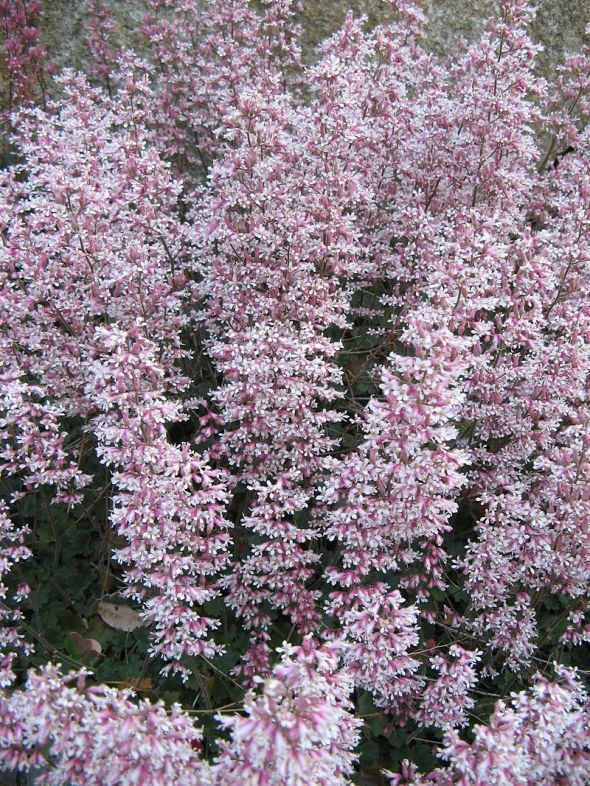Heuchera Plant Care Guide and Varieties (Coral bells)
Heuchera Plant Care
Overview
Heuchera, also known as coral bells, alum root or Saxifragaceae, is an herbaceous perennial plant commonly grown as ground cover available in a wide variety of colors, sizes and textures. The name coral bells reflects the appearance of the ornamental flowers, though the semi-evergreen foliage is an attractive feature in itself. Heuchera, native to North America, thrives in USDA hardiness zones 3 through 11 and often grows with little to no care in most temperate regions.
Site and Soil
Plant your heuchera in a location with moist, well-drained, fertile soil that receives partial shade throughout the day. The plant tolerates full sun or full shade, but partial shade yields the best results. A soil amendment of organic compost increases the drainage and fertility of the soil to adequate levels. Heuchera grows well and provides a nice accent in a location near other herbaceous perennials. Spacing separate plantings 10 to 16 inches apart provides plenty of room for growth.
Watering
Watering once every seven days will prevent the soil from drying out completely. Heuchera needs consistently moist soil to thrive, especially in hotter climates. To reduce the risk of foliar disease, heuchera requires watering during the early morning so any excess moisture can evaporate before evening. Drip irrigation effectively delivers moisture directly to the soil, further reducing the plant’s vulnerability to disease.
Mulching
Spreading a 2-inch layer of mulch over the soil surrounding heuchera helps insulate the soil during winter and improve moisture retention. About 3 inches of space between the plant’s crown and the mulch allows air circulation, which prevents rotting and disease. Replenishing the mulch throughout the year ensures proper winter protection and hinders the establishment of competitive weeds.
Fertilizing
Apply a 10-10-10 NPK fertilizer monthly during the spring and summer months at half the rate recommended by the manufacturer’s instructions. Watering the soil before and after applying prevents root burn and dissolves the fertilizer, releasing the nutrients. Heuchera requires minimal nutrients and does not require fertilization during the fall or winter months.
Dead-Heading
Removal of faded heuchera flowers extends the blooming season and encourages the plant to form additional blossoms. This process, known as dead-heading, also prevents the plant from producing seeds and invading other portions of the lawn or garden. Severing the flower stems at their point of origin minimizes damage to the plant and makes re-blooming less stressful.
**************
From Wikipedia …
The following cultivars have gained the Royal Horticultural Society‘s Award of Garden Merit:-
- ‘Blackbird’[3]
- ‘Burgundy frost’[4]
- ‘Can-can’[5]
- ‘Chocolate veil’[6]
- ‘Fireworks’[7]
- ‘Magic wand’[8]
- ‘Molly bush’[9]
- ‘Purple petticoats’[10]
- ‘Quilter’s joy’[11]
- ‘Raspberry regal’[12]
- ‘Sashay’[13]
- ‘Smokey rose’[14]
Selected species
- Heuchera abramsii – San Gabriel Alumroot
- Heuchera alba – White Alumroot
- Heuchera alpestris – San Bernardino Alumroot
- Heuchera americana – American Alumroot
- Heuchera brevistaminea – Laguna Mountain Alumroot
- Heuchera x brizoides – Coral Bells (Hybrids)
- Heuchera cespitosa – Tufted Alumroot
- Heuchera chlorantha – Green-flowered Alumroot
- Heuchera cylindrica – Roundleaf Alumroot, Lava Alumroot
- Heuchera duranii – Duran’s Alumroot
- Heuchera elegans – Urnflower Alumroot
- Heuchera hirsutissima – Shaggy-haired Alumroot
- Heuchera maxima – Island Alumroot, Jill-of-the-Rocks
- Heuchera merriamii – Merriam’s Alumroot
- Heuchera micrantha – Crevice Alumroot, Smallflower Alumroot
- Heuchera parishii – Mill Creek Alumroot
- Heuchera parvifolia – Small-flowered Alumroot
- Heuchera pilosissima – Seaside Alumroot, Parish’s Alumroot
- Heuchera pubescens – Appalachian heuchera
- Heuchera pulchella – Sandia Alumroot
- Heuchera richardsonii – Richardson’s Alumroot
- Heuchera rubescens – Pink Alumroot
- Heuchera sanguinea – Coral Bells
- Heuchera villosa – Hairy Alumroot, Maple-leaved Alumroot
- Heuchera wootonii – Wooton’s Alumroot
Also … Native Plant Database ~ Here











Recent Comments